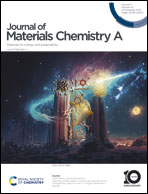One-step hydrothermal synthesis of Se-doped NiTe electrocatalysts for efficient hydrogen production from saline water assisted by anodic iodide oxidation†
Abstract
Hydrogen production through direct seawater electrolysis has shown substantial promise because of the abundance of seawater and the favorable possibility of combining offshore solar and wind with water electrolysis to produce green hydrogen. However, direct seawater electrolysis currently still faces formidable technical challenges. In particular, the interfering chlorine evolution reaction (CER) comes into play at high voltages, not only competing with the oxygen evolution reaction (OER) and thereby compromising the faradaic efficiency, but also generating corrosive and environmentally unfriendly substances that can reduce the lifetime of materials and components in the electrolyzer. Herein, we develop a selenium-doped nickel telluride nanoarray electrode on a nickel foam current collector (Sex-NiTe/NF) via a one-step hydrothermal method. We demonstrate that the optimized Sex-NiTe/NF (Se25-NiTe/NF) has rich catalytically active sites and Se doping helps enhance the OER performance in simulated alkaline seawater electrolyte (1.0 M KOH + 0.5 M NaCl). Furthermore, we add potassium iodide (KI) into the simulated seawater electrolyte and prove for the first time that during saline water electrolysis the iodide oxidation reaction (IOR) can substitute for the energy demanding OER, making the anodic half reaction happen at a potential markedly lower than the onset of the CER. As such, the Se25-NiTe/NF electrode only needs an anodic potential of 1.376 V vs. the reversible hydrogen electrode to reach 100 mA cm−2, and moreover it can continuously catalyze the IOR at this current density for 500 hours with minimal degradation. Besides, we prove that the overall saline water electrolysis can be achieved with reduced demand for electricity, by coupling the IOR with the hydrogen evolution reaction (HER), and can operate at 100 mA cm−2 continuously for 100 hours without notable degradation. Our density functional theory calculations reveal that Se doping favors electron transfer from the active nickel sites to reaction intermediates and meanwhile reduces the energy barrier to the potential-determining step of the reactions, thereby boosting the catalytic performance.



 Please wait while we load your content...
Please wait while we load your content...